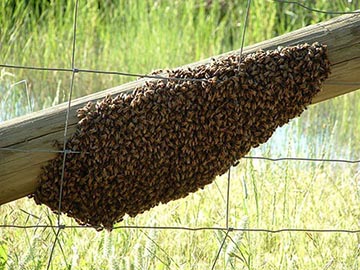Springtime is a busy time for honey bees and beekeepers alike. As more and more flowers and trees begin to bloom, the amount of nectar and pollen available for the bees increases. The worker bees will be busy bringing in all that nectar and pollen. The queen will also be busy laying eggs. She is the only bee in the hive that lays eggs and that is all she does for her entire life. With all the pollen and nectar (food) coming into the hive and the queen laying several hundred eggs a day, the population of bees in the hive rapidly expands from its winter low.
As the number of bees increases, the amount of queen pheromone that is passed to the individual bees decreases. The decrease in queen pheromone triggers the worker bees to start the process of raising a new queen to replace the old one. The queen also begins to have trouble finding a place to lay eggs because so many of the honeycomb cells are taken up with the abundant pollen and nectar that is being gathered and brought into the hive.

Beekeepers can add empty comb and do other things to give the bees more space, but if that doesn’t happen or doesn’t happen in the right time frame then the hive will begin to make swarm preparations. Even if the beekeeper does everything right, a hive will still sometimes swarm. Then there are the feral hives that don’t belong to a beekeeper. It is estimated that 9 out of 10 feral hives swarm every year.
When a hive swarms, the queen and approximately half the bees in the hive leave. The swarm of bees will land somewhere until a location for a new hive can be found. They can land anywhere – a tree branch, a swing set, the side of a propane tank, under a porch roof, etc. A swarm can also vary in size – some are small, about the size of a baseball, while others are larger, closer to the size of a basketball.
A few years ago I happened to be home when one of our hives swarmed. All I can say about it is “wow!” It was an amazing sight and feeling to be in the middle of the start of a swarm. There were bees everywhere, all frantically buzzing and flying around as they tried to get the queen to leave the hive. When she left the hive, all the bees that only seconds before had been flying around in what looked like complete, disorganized, chaos suddenly grouped up much like you see the big flocks of starlings do in the fall. Then they all flew off as a single cluster of bees. However, if you aren’t used to being around bees, seeing a swarm can be a bit scary because there are so many bees in one place.
Although a big cluster of bees may look scary, honey bees in a swarm are usually fairly gentle unless provoked. All they are interested in is finding a new home. While most of the bees in the swarm group up, a few scout bees go house hunting. When one of them finds a possible location, it comes back and does a little dance on the surface of the swarm to tell other bees where the possible site is located. Other bees go check it out and eventually the swarm will come to a consensus as to the best location and everyone will fly to their new home. The process can take a couple of hours to a couple of days. If you want to know more about how a swarm picks a new hive location, Tom Seeley has a great book about it titled Honey Bee Democracy.
If you find a swarm, please don’t kill it. You can ignore it and within a relatively short time the bees will leave because they’ve found where they want to establish their new hive. Or you can call your favorite local beekeeper. (Please say that is me, if you are in the general Barren, Metcalfe, or Warren county areas of Kentucky!) Often he or she will be happy to collect your swarm, take it home, and establish a new hive of bees. If you don’t know any local beekeepers, call your county extension office, fire department, or police department. They will typically have a list of local beekeepers who are interested in collecting swarms. Just don’t call 911 – a swarm of bees is not a life-threatening emergency.

This article was part of Shannon’s original Kentucky Pollinators and Backyard Wildlife blog which evolved into the blog for Backyard Ecology.

Backyard Ecology: Exploring Nature in Your Backyard
Nature isn’t just “out there.” It’s all around us, including right outside our doors. Hi, my name is Shannon Trimboli, and I am the host of Backyard Ecology. I live in southcentral Kentucky and am a wildlife biologist, educator, author, beekeeper, and owner of a nursery specializing in plants for pollinators and wildlife conservation. I invite you to join me as we ignite our curiosity and natural wonder, explore our yards and communities, and improve our local pollinator and wildlife habitat. Learn more or subscribe to my email list at www.backyardecology.net.

Leave a Reply